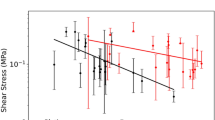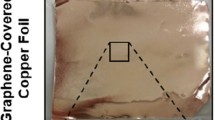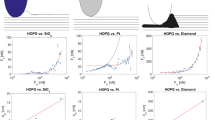Abstract
In this work, we compare the friction behavior of single asperity contacts of a PtSi tip with copper and monolayered graphene on copper. For both PtSi/copper—and PtSi/graphenized copper tribological couples, we measured 16 differently oriented grains with three different sliding velocities as a function of the load by atomic force microscopy to assess the role of crystallographic orientation on friction and its rate dependence. We find that friction on copper is governed by shearing and does not depend on the crystallographic orientation but is significantly affected by the sliding velocity. We discuss this dependence based on contact aging in ambient conditions and shear strain rate sensitivity. In contrast, we find that friction of a graphene monolayer on copper is governed by puckering and depends both on the crystallographic orientation of the underlying grain and on the sliding velocity. We discuss these dependencies based on the orientational commensurability of the graphene lattice with the underlying copper crystallographic plane and on thermolubricity. Beyond their validity at the nanometer scale, our results are relevant to extend the understanding of friction between engineered surfaces at the macro- and micro-scale, where contacts initiate at nanometer-scale asperities.














Similar content being viewed by others
References
Bowden FP, Tabor D (1950) The friction and lubrication of solids. Oxford University Press, Oxford, U.K.
Ko HE, Kwan SG, Park HW, Caron A (2018) Chemical effects on the sliding friction of Ag and Au(111). Friction 6:84–97
Ko HE, Park HW, Jiang JZ, Caron A (2018) Nanoscopic wear behavior of face-centered cubic metals. Acta Mater 147:203–212
Kwon SK, Kim HD, Pei XQ, Ko HE, Park HW, Bennewitz R, Caron A (2019) Effect of cooling rate on the structure and nanotribology of Ag–Cu nano-eutectic alloys. J Mater Sci 54:9168–9184. https://doi.org/10.1007/s10853-019-03533-5
Petzold C, Koch M, Bennewitz R (2018) Friction force microscopy of tribochemistry and interfacial ageing for the SiOx/Si/Au system. Beilstein J Nanotechnol 9:1647–1658
Gosvami NN, Feldmann M, Peguiron J, Moseler M, Schirmeisen A, Bennewitz R (2011) Ageing of a microscopic sliding gold contact at low temperature. Phys Rev Lett 107:144303
Brechet Y, Estrin Y (1994) The effect of strain rate sensitivity on dynamic friction of metals. Scripta Metall Mater 30:1449–1454
Estrin Y, Brechet Y (1996) On a model of frictional sliding. Pageoph 147:745–762
Filleter T, Bennewitz R (2010) Structural and frictional properties of graphene in SiC(0001) studied by atomic force microscopy. Phys Rev B 85:155412
Cho DH, Wang L, Kim JS, Lee GW, Kim ES, Lee SH, Lee SY, Hone J, Lee CG (2013) Effect of surface morphology on friction of graphene on various substrates. Nanoscale 5:3063–3069
Klemenz A, Pastewka L, Balakrishna SG, Caron A, Bennewitz R, Moseler M (2014) Atomic scale mechanisms of friction reduction and wear protection by graphene. Nano Lett 14:7145–7152
Chan N, Balakrishna SG, Klemenz A, Moseler M, Egberts P, Bennewitz R (2017) Contrast in nanoscale friction between rotational domains of graphene on Pt(111). Carbon 113:132–138
Egberts P, Han GH, Liu XZ, Jonhson TC, Carpick R (2014) Frictional behavior of atomically thin sheets: hexagonal-shaped graphene islands grown on copper by chemical vapor deposition. ACS Nano 8:5010–5021
Batzill M (2012) The surface science of graphene: Metal interfaces, CVD synthesis, nanoribbons, chemical modifications, and defects. Surf Sci Rep 67:83–115
Seah CM, Chai SP, Mohamed AR (2014) Mechanisms of graphene growth by chemical vapour deposition on transition metals. Carbon 70:1–21
Marchon B, Carrazza J, Heinemann H, Somorja GA (1988) TPD and XPS studies of O2, CO2 and H2O Adsorption on clean polycrystalline graphite. Carbon 26:507–514
Butt H-J, Jaschke M (1995) Calculation of thermal noise in atomic force microscopy. Nanotechnol 6:1–7
Sangwal K (1987) Etching of crystals: theory, experiment, and application. North-Holland, Amsterdam, The Netherlands
Deng S, Berry V (2016) Wrinkled, rippled and crumpled graphene: an overview of formation mechanisms, electronic properties, and applications. Mater Today 19:197–212
KL Johnson, K Kendall, AD Roberts (1971) In:Proc R Soc London Ser A 324: 301–313
Antczak G, Ehrlich G (2010) Surface diffusion: metals, metal atoms, and clusters. Cambridge University Press, Cambridge, U.K.
Dao M, Lu L, Shen YF, Suresh S (2006) Strength, strain-rate sensitivity and ductility of copper with nanoscale twins. Acta Mater 54:5421–5432
Frank O, Vejpravova J, Holy V, Kavan L, Kalbac M (2014) Interaction between graphene and copper substrate: the role of lattice orientation. Carbon 68:440–451
Boyko EV, Kostogrud IA, Bezrukov IA, Krivenko AS, Smovzh DV (2019) The influence of the crystallographic orientation of the copper catalytic substrate crystallites on the mechanical transfer of graphene. Mater Res Express 6:125628
Dienwiebel M, Verhoeven GS, Pradeep N, Frenken JWM, Heimberg JA, Zandbergen HW (2004) Superlubricity of graphite. Phys Rev Lett 92:126101
Popov VL, Gray JA (2012) Prandtl-Tomlinson model: history and application in friction, plasticity, and nanotechnologies. Z Angew Math Mech 92:683–708
Acknowledgement
This work was partially supported by the Graduate School Research Program of KOREATECH.
Author information
Authors and Affiliations
Corresponding author
Additional information
Handling Editor: Catalin Croitoru.
Publisher's Note
Springer Nature remains neutral with regard to jurisdictional claims in published maps and institutional affiliations.
Electronic supplementary material
Below is the link to the electronic supplementary material.
Rights and permissions
About this article
Cite this article
Oh, Y.C., Kwon, S.K., Minkow, A. et al. Effect of crystallographic orientation on the friction of copper and graphenized copper. J Mater Sci 55, 16432–16450 (2020). https://doi.org/10.1007/s10853-020-05178-1
Received:
Accepted:
Published:
Issue Date:
DOI: https://doi.org/10.1007/s10853-020-05178-1




